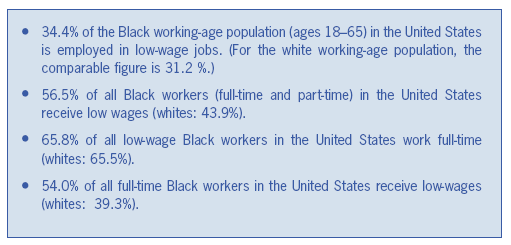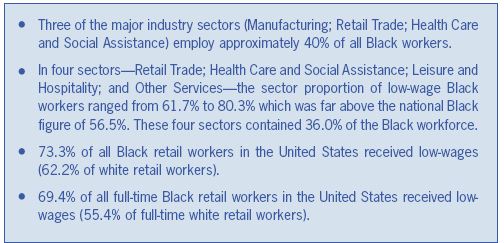
|
|||||||||||||||||||||
|
||||||||||
|
||||||||||
Executive Summary
|
||||||||||
Cover photo by Steve Cagan The Center for Labor Research and Education, UC Berkeley is an affiliate of the University of California Miguel Contreras Labor Program This research was funded by grants received from the Akonadi Foundation and the Arca Foundation. The project was completed with the assistance of Hannah Betesh and Ginny Fang. Click here to view the Executive Summary report in printer friendly PDF format. Click here to view the full report. Executive SummaryIntroductionSince the end of slavery, visionaries within the Black community, including Ida B. Wells, W.E.B. DuBois, and Paul Robeson, have led a freedom movement with the dual objectives of eliminating racial inequality and improving the quality of life for Blacks in the United States. Beginning in the mid-1950s with the Brown v. Board of Education Supreme Court decision and the Montgomery Bus Boycott, this struggle took the form of the modern civil rights movement. Thirty-five years have passed since the victories of this movement, and we have entered into a new era, one marked by a radically different global economic and political context. This report, "Job Quality and Black Workers: An Examination of the San Francisco Bay Area, Los Angeles, Chicago, and New York," looks at one sphere of Black life - the labor market - and takes stock of the realities for Black workers in the context of 21st century globalization. It presents a detailed view of the Black workforce with a focus on the incidence of low-wage work.ii [This Executive Summary only contains data on the United States; see the full report for data on the four metropolitan areas.] The research presented in this report1 led to three important conclusions. First, the Black community in the United States faces a two-dimensional crisis concerning employment: the crisis of unemployment and the crisis of low-wage jobs. The crisis of unemployment is the typical face of the jobs problem among African Americans. The other serious problem is the crisis of low-wage jobs held by Blacks who have employment. Too many African Americans work at jobs that do not provide wages (and benefits) to properly raise a family. The purpose of this research project is to gain a deeper understanding of the fate of Blacks who have jobs. A second key conclusion of the research is that the incidence of low-wage Black employment is concentrated in certain key industry sectors. Among all Black workers, 56.5% work for low wages; however, the four sectors where the percentage of low-wage Black employment exceeds 60% - Retail Trade; Health Care and Social Assistance; Leisure and Hospitality; and Other Services - contain approximately one-third of all Black workers. Thus, any set of strategies that seek to improve job quality for Black workers must address these sectors which hire a significant number of Black workers and pay poorly. Finally, the research begins to outline how new global economic realities are having an impact on future employment prospects for Black workers. In contrast to popular perception, these realities go beyond job flight from the United States offshoring to encompass the expansion of industries that are more rooted in this country. Data reveals that Blacks have a significant presence in those industries that are more place-based with less vulnerability to offshoring. Many of these same industries have been projected as growth industries and many employ high numbers of low-wage Black workers. These facts imply that strategies to address the job crisis must look at these industries which will do well in the new global economy and find ways to transform the job quality in these industries. These conclusions point to the need for a multi-faceted approach to solve the jobs crisis in the Black community: an approach that addresses the issue of low-wage work, the issue of unemployment, and the need for regional economic development policies while simultaneously seek economic growth and equity. Fighting the crisis of unemployment requires substantive programs which lower the barriers to job access. These barriers are individual and structural, and both types of barriers must be attacked in order to expand employment opportunities. However, programs designed to increase employment opportunities for African Americans will have limited value on the scale that is needed if a large portion of jobs which are created are low-wage jobs. These low-wage jobs need to be transformed into better quality jobs. Thus, the fight for job access must be intertwined with the fight for job transformation. Some community advocates citing the need for jobs (and retail shopping opportunities) support economic development plans that target the retail sector in an attempt to either revitalize downtown districts or generate tax revenue. However, the entry of stores such as Wal-Mart results in employment at low wages with little or no benefits. Thus, the presence of Wal-Mart in central city communities reflects a perceived Hobson's Choice between no jobs or low-wage jobs. The dilemma of no jobs or low-wage jobs reflects the dominance of "low road" economic development policies. These policies seek to attract businesses to regions and cities regardless of the quality of jobs they offer residents. When jurisdictions travel the "low road," they follow a path that fosters intense competition between cities for tax bases and a vicious race to the bottom: local governments offer higher and higher subsidies that actually lower the net benefits of the firm's presence in a region. The proliferation of these policies has created an atmosphere such that any efforts to mitigate the negative impacts of new firms or create labor standards are decried by many local leaders as antithetical to the economic health of the region. The path of "low road" economic development assists in the growth of a low-wage economy. What is needed is to go "beyond Wal-Mart" to identify public policies that raise labor standards and transform bad jobs as well as reduce the high levels of unemployment. What is also needed are policies designed to empower poor communities and their residents in economic decision-making. Public policies are a result of political compromise and relative political power; if poor communities do not have substantial power, local economic development policies will generate few gains for poor people. Foremost are policies that will allow workers to organize on their own behalf without the interference of employers. Union representation is an indispensable weapon for low-wage workers who seek to raise the quality of the jobs they hold. However, in the past thirty years, the right to organize has been under attack as deliberate efforts by businesses combined with government regulatory neglect and rapid changes in the structure of the economy have resulted in the lowest levels of unionization since the Great Depression. The impact of the loss of effective workplace collective action includes lower living standards and the loss of dignity on the job. Low-wage Employment and Black Workers
This report will focus on the wage dimension of job quality. For our purposes, we define a low-wage job in 1999 to be a job that paid a wage less than or equal to $12.87 per hour. This figure was twice the 1970 minimum wage adjusted for inflation. In 1970, the federal minimum wage was 47% of the average wage for non-supervisory workers in the private sector; in 2000, this share fell to 37%. (By 2006, the share had fallen even further to 31%.) Hence the use of an inflation-adjusted 1970 minimum wage threshold for low-wage work implies the use of a threshold that would exist if the real value of the 1970 minimum wage been maintained. An Overview of the Black Working-age PopulationThe Black working age population (18-65) can be divided into four categories: full-time work; part-time work; irregular work; and didn't work last year. These terms were defined as follows:
Chart 2.3A presents data on the Black working age population. In the United States, 60.8% of the Black working-age population was working either full-time or part-time in 1999. Twenty-six percent of the Black working-age population in the United States did not work in 1999. (By way of comparison, 17.8% of the white working-age population in the United States did not work in 1999. )
The Crisis Of Low-Wage Work In The Black CommunityThe data indicates two components of the crisis of low-wage work. First, a significant segment of the Black working age population works for low-wages. Second, just looking at Black workers, a set of people smaller than number of people in the working age population, the research reveals that a large share of Black workers receive low-wages. Using the thresholds for low-wage work, the data can be re-organized to illustrate the first component of the crisis of low-wage work in the Black community. In Chart 2.4A, full-time and part-time workers have been re-categorized as low-wage and non low-wage workers; in addition, individuals who were irregular workers or did not work in 1999 have been grouped together. During that year, one-third of the Black working-age population in the United States held low-wage jobs. (The comparable figure for the white population in the United States was 31.2%.) This figure approaches the share of the Black working age population that either did not work or worked irregularly: 39.3%. (For the white population, the corresponding figure was 28.9%.)
The second component of the low-wage work crisis is the high propensity for Black workers to earn low wages. Just looking at Blacks who work full-time or part-time, 56.5% of all Black workers in the United States were employed in low-wage jobs. Often, the source of low-wage work is claimed to be the prevalence of part-time work. However, two-thirds of all low-wage Black workers in the United States (65.8%) work full-time. The Industrial Distribution of Black Employment
Where Are Black Workers Concentrated?The United States economy can be divided into 15 major non-farm industry sectors. Three of the sectors (Manufacturing; Retail Trade; Health Care and Social Assistance) employ approximately 40% of all Black workers. Examining the nation's workforce as a whole, Blacks comprise 11.1% of workers. Three sectors are disproportionately Black: Transportation; Health Care and Social Assistance; and Public Administration. Blacks are significantly underrepresented in three sectors: Mining; Construction; and Wholesale Trade. In the remaining nine industry sectors, the proportion of Black workers present is within 1.9% of the workforce average. Industrial Distribution Of Low-Wage Black WorkersAs stated earlier, 56.5% of Black workers in the United States received low wages in 2000. In four sectors - Retail Trade; Health Care and Social Assistance; Leisure and Hospitality; and Other Services - the sector proportion of low-wage Black workers was far above the national average. These four sectors contained 36.0% of the Black workforce. In seven sectors - Mining; Utilities; Transportation; Information; Financial Services; Educational Services; and Public Administration (34.3% of the Black workforce) - the sector proportion of low-wage Black workers was below the national average. In the remaining four sectors - Construction; Manufacturing; Wholesale Trade; Professional and Business Services - the proportion of low-wage Black workers approximated the national average. (There were 29.7% of Black workers in these sectors.) Retail Trade-A Site Of Racalized BattlesOf the industries discussed above, Retail Trade has been a particularly contentious site of political battles. There are many pressures to expand the retail industry in urban areas. First, many urban areas are an untapped market for large retail businesses such as Wal-Mart. Second, as some retail stores leave central cities to follow their middle class customer base to suburban areas, the influx of immigrants to the urban core brings with it a need to satisfy the consumer demand of these new residents. Third, many state tax structures have constrained the ability of cities to raise funds except through sales tax revenue; hence, the attraction of retail to cities is as a mechanism to fill cities' treasuries. Fourth, a key feature of the dynamics of the Black community in metropolitan areas has been the dispersion of Black residents across the region and the impoverishment of old Black neighborhoods. This increasing poverty and the lack of quality retail outlets have led many advocates of Black community economic development to fight for new retail establishments. However, this last effort occurs in very complicated terrain. Advocates wishing to bring large retail stores to inner-city neighborhoods are often opposed by groups fighting the negative byproducts of these establishments. Among these spillover effects are: the drain on public monies due to associated tax subsidies and infrastructure expenditure; increased traffic congestion; the elimination of neighborhood-based small businesses; and the reduction of wages for retail workers. This last factor is often debated in racialized terms as proponents of retail development portray themselves as promoters of Black community uplift while simultaneously painting their opponents (labor unions and others) as either defenders of white privilege, adversaries of Black economic growth, or both. As this highly charged argument takes place, more and more research is documenting the negative impacts on wages of large retail establishment such as Wal-Mart. For instance, Dube, Eidlin, and Lester have found that when a Wal-Mart store opens in a metropolitan area county, average earnings per worker fall by 0.5% to 0.8% in the general merchandise sector of retail. In the grocery sector, average earnings per worker fall 0.8% to 0.9%.vi Black Workers In The Retail IndustryThe retail industry has employed a growing share of U.S. workers since 1980. In 1980, 7.0% of all workers were employed in retail; by 2000, that share had increased to 10.9%. This trend was true for Black workers: in 1980, 5.4% of all Black workers were in retail; in 2000, the proportion had grown to 9.1%. As expected, the retail industry is a low-wage industry. In the United States, approximately 73% of all Black retail workers are low-wage workers. While a large portion of the Black retail workforce is part-time, full-time Black retail workers still have a high propensity to receive low-wages. In the nation, 60% of all Black retail workers are full- time. Of these full-time retail workers, 69.4% are low-wage. These Black workers are adversely impacted by the entry of Wal-Mart (and other large retail employees paying low wages) into their city. Consequently, the racially charged debate needs to be re-examined. Globalization, Job Quality, and Black Workers
Globalizartion, "Offshorability," And Job QualityWhen popular commentators speak of globalization, they often link it to the loss of jobs in the United States to other countries, the pressures on U.S. workers' wages, or both. Unfortunately, this perspective captures only a portion of the impact of globalization on jobs. A more complete view recognizes that globalization in the 21st century is causing a new division of work around the world. Just as many tasks that were performed by workers in this country now are being performed by workers in other countries, the numbers of other jobs in this country are growing. In a series of papers published in 2006 and 2007, Alan Blinder attempts to explore more deeply the issue of which jobs are offshorable.vii The old view of offshorability was that any job that produced something that could be boxed and shipped was a job that could be off-shored. In common parlance, these jobs were located in the manufacturing sector of the economy, and the offshoring firms produced goods and not any "intangible" services. In recent years, as many high technology jobs have shifted overseas, this view has been updated to recognize the potential loss of service jobs. A more complete view raises the basic question: does the transaction need to be personally delivered? Cars can be produced anywhere and then shipped to the consumer. Customer service calls from the United States can be answered anywhere as long the call operator has the technical and linguistic ability. Warehouses that receive foreign goods must be relatively close to the residences of consumers. Providers of care for children, the elderly, and the disabled must be within arms-reach of those they serve. Black Workers And Job OffshorabilityThis section attempts to combine Blinder's broad notions of offshorability as he applied them to the major industry sectors with data on the presence of Black workers in these sectors. The four charts below present "guesstimates" of how offshorable an industry might be. Given the rough approximations that accompany using industry sectors as the unit of analysis, nothing is surprising in the charts. These "guesstimates" are supplemented by December 2005 Bureau of Labor Statistics employment projections, which report employment levels for 1994 and 2004 and projected employment in 2014. The charts present the share of projected growth that each industry sector will contain. The charts also show the percent of Black workers in each sector who are low-wage.
Almost one-half of Black workers are employed in industries with a reduced threat from off-shorable jobs ("highly non-offshorable"). Two sectors are projected to have zero or negative job growth between 2004 and 2014. In the remaining sectors, most have high incidences of low-wage Black workers or are highly unionized (Construction; Public Administration). In the category of "non-offshorable," Health Care and Social Assistance is expected to contribute 23% of the job growth between 2004 and 2014 and currently, approximately 62% of the Black workers in this sector receive low wages. Among the "mixed" industries, the Professional and Business Services sector requires closer examination. The industry will be a significant contributor to job growth, and it is clear that some of the jobs in the sector, including janitorial services and security services, are "locked" in this country as long as there are property and buildings to clean and secure. How does this information relate to the issue of Black workers, job quality and public policy? Consider the typology of jobs sketched in Chart 4.6-A.
Jobs that fall in the first row are those that will be difficult to offshore in the foreseeable future due to the nature of the job, its relationship to the production and delivery of the good and/or service, and the nature of existing technology. Jobs that fall into the second row are under a more immediate threat to be sent offshore. Workers performing jobs in the first column receive low wages; higher paying jobs fall into second column. Quadrant I jobs pay poorly but can be expected to be performed in the country for some time. Quadrant II jobs should be stable in this country for awhile, but pay better than Quadrant I jobs. Quadrant III jobs pay poorly, but, due to the nature of the global economy, they might be sent offshore soon. Quadrant IV jobs pay better than Quadrant III jobs, but their existence in this country is threatened. Consider the jobs in each of the four quadrants from the perspective of worker attractiveness and public policy. We should gladly say farewell to Quadrant III jobs and welcome the global currents that take these jobs away. Quadrant II jobs are welcomed, and public policy should attempt to strengthen these sectors and develop job training programs so that the unemployed, youth, and persons re-entering the labor force have prospects at getting these jobs. Quadrant IV jobs pose a more vexing public policy dilemma. Some of these jobs may be desirable, but given economic realities, preserving these jobs will require a transfer of income and resources into these sectors to prevent their disappearance. Quadrant I jobs are those that are typically ignored when discussing public policy and job quality. No one speaks of training individuals for these jobs. Economic development plans with criteria for job quality do not attempt to attract these industries. However, these jobs exist and their numbers are growing; someone is going to hold these jobs and no amount of individual skill development will alter this reality. To the extent that the concern for job quality stems from a concern for workers, policy advocates must begin to examine ways to improve the quality of these jobs. Conclusion: Using Public Policy to Improve Job Quality for Black WorkersThese data indicate that the approach to the jobs crisis in the Black community needs to be broadened in two fundamental ways. First, policy advocacy and resource allocation must expand to include grappling with issues of low-wage work. Large numbers of Blacks work in low-wage industries; many of those industries will experience substantial employment growth by 2014; and many of the growth industries face less of a threat from offshoring compared to other industries. Job training programs alone will not deal with this reality of a growing number of low-wage jobs. Second, the dominant focus on individual behavior must be expanded to examine the job opportunity structure presented by the economy. Currently, most questions of workers ask what skills they have or don't have; which of their behaviors are positive or dysfunctional; and how to move them away from their current job. Little effort is made to understand why certain jobs are created; what determined the level of pay in these jobs beyond individual characteristics; and what choices do low-wage workers face in the labor market. In a context where an extremely large number of jobs are projected in occupations that currently offer low wages, it is important to expand our knowledge beyond the traits of individual workers and examine the structure of the economy. We need to do more than attempt to move workers out of these jobs; we need to seek ways to improve the jobs that will be created. This examination of the opportunity structure must include understanding how the patterns of the 21st global economy affect low-wage Black workers. Given this two-dimensional crisis of work in the Black community, effective policy responses are needed in three broad areas: Low-wage Work; Unemployment; Regional Economic Development. Low-Wage Work
Unemployment
Regional Economic Development
Click here to view the Executive Summary report in printer friendly PDF format. Click here to view the full report.. BlackCommentator.com Editorial Board member, Steven Pitts, PhD, is a Labor Policy Specialist at the UC Berkeley Center for Labor Research and Education. Click here to contact Dr. Pitts. |
||||||||||
| September
6, 2007 Issue 243 |
|
| Printer Friendly Version in resizeable plain text format format |
 |
 |
 |
| |
| |








































